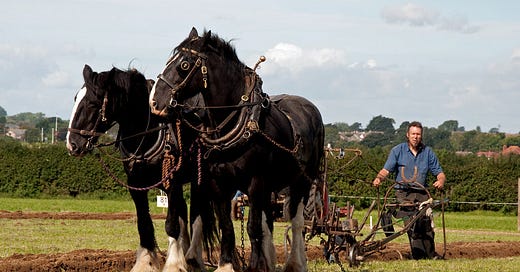Plough Monday was, or is, a public holiday following Twelfth Night. In medieval times in arable districts of eastern England festive merry-making ended with the preparations for ploughing. In the East Midlands ‘plough lights’ were kept burning in many churches and in some churches ploughs were mounted on stands. It seems that ploughs kept in churches were blessed upon Plough Sunday, the first Sunday after Epiphany.
The formal opening of the ploughing season was the following day. This was often accompanied with joviality. Thomas Tusser of Essex recorded the custom of ploughmen trying to put an object in the fire before young women could put a kettle of water onto it, with prizes given to the winners. In East Anglia and the East Midlands a plough, perhaps that from the church, was dragged around the streets and money collected for parish funds, usually by the young men. Sometimes the proceeds went directly to the upkeep of the plough light. In some places there were feasts and loans of money and ploughs arranged for the poor.
Horses and Plough – Boverton © Mick Lobb (CC BY-SA 2.0)
John Bale, a Protestant writing in the mid-sixteenth century bemoaned the ‘conjuring of ploughs’, the Plough Sunday blessing.[1] Around this time the Reformation of religion led to the ending of many traditional practices, including collections on Plough Monday. In at least one parish, Holme Pierrpoint in the Trent Valley, this collection had previously been the main source of income. We know this as in 1552, shortly after their Plough Monday practice was ended, a rate was levied on the parish to make up the difference.[2] By 1600 Plough Monday had ceased to be connected to parish finance, with collections merely relics of their previous importance. The communal plough was however still kept in some churches, though the blessing of it appears to have stopped.
Plough Monday continued in some form beyond its traditional one. Into the eighteenth century the parish funds of Waddington, to the south of Lincoln, were administered by ‘ploughmasters’ who were appointed bell ringing and music.[3] Along with Hocktide and May games, Plough Monday collections continued as private ventures, though now uncoupled from parish life according to historian Ronald Hutton.[4] By the late eighteenth century, and possibly before this, the dragging of the plough was accompanied by the young men giving a performance of a play involving song, dance and verse.[5] This was generally a version of the one performed by the Mummers, on the subjects of combat, death, and revival. Though with additional detail on the courting and marrying of a Fool.
In rural areas, such as Lincolnshire, where the practice survived into the nineteenth century players toured local farmhouses and were rewarded with food and drink.[6] In some places in eastern England vestiges of Plough Monday celebrations survive to this day, a testament to the continuing desire for revelry at this cold, dark time of year.
References and Resources:
Information for this post was taken from the excellent Ronald Hutton, The Rise and Fall of Merry England: The Ritual Year, 1400-1700 (1994), 16-17.
Ronald Hutton, The Stations of the Sun: A History of the Ritual Year in England (2001), 124-133
David Hey (ed.), The Oxford Companion to Local and Family History (1996), 359
Alun Howkins and Linda Merricks, ‘The Ploughboy and the Plough Play’, Folk Music Journal 6:2 (1991)
[1] Ronald Hutton, The Rise and Fall of Merry England: The Ritual Year, 1400-1700 (1994), 16.
[2] Ibid., 87-8.
[3] Ibid., 119.
[4] Ibid., 120.
[5] David Hey (ed.), The Oxford Companion to Local and Family History (1996), 359.
[6] Hey (ed.), The Oxford Companion, 359.






Thanks for this Joe really informative, coming from a long line of Ag.Labs I should have really known this but I didn't! Thanks mate
That was so interesting, thank you! I have never heard of Plough Monday before.